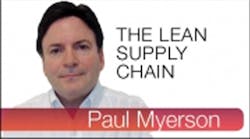It sure seems like there is a lot more risk involved in operating in today’s global environment, such as exposure to natural disasters, political turmoil, terrorism, etc.
In fact, according to Deloitte LLP, there are more than 200 current and emergent risks that may have an impact on supply chains and “85 percent of global supply chains experienced at least one disruption in the last 12 months”. Furthermore, “the vast majority of manufacturers do not have a plan in place to mitigate supply chain specific risks”. (“Supply Chain managers must be trained to “visualize” risk”).
As a result of this growing risk to the supply chain, there is now a specific strategy employed by an increasing number of organizations known as “Supply Chain Risk Management” (SCRM). This involves a strategy to manage all kinds of risks that may affect the supply chain by continuously assessing potential risks with a goal of reducing an organizations’ supply chain vulnerability and ensuring continuity when these types of events do occur.
Deloitte also points out that while supply chains are a great place to help an organization achieve efficiencies through a variety of Lean tactics such as helping a company to employ a Just-In-Time (JIT) manufacturing strategy, rising supply chain costs (50-70% of sales in many cases) as a result of disruptions caused by exposure to many of these global risks can cause profitability to suffer significantly.
So, at least to some degree, supply chain efficiency and risk management may be considered polar opposites and trade-offs must be made to achieve both successfully.
To help mitigate risk to the supply chain, Deloitte urges companies to try to “visualize” potential risks and to attempt to quantify and prioritize them.
This can be aided by using available data analytic tools as well as other value added service providers. It’s also not a bad idea to put someone in charge of risk management and make sure they are properly trained on the subject (note: shameless plug to follow…) by organizations such as the Center for Value Chain Research (CVCR) at Lehigh University.



